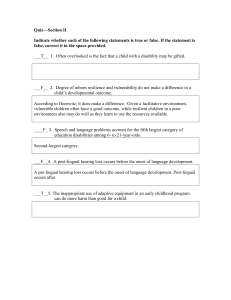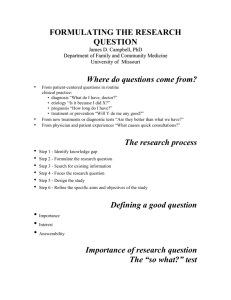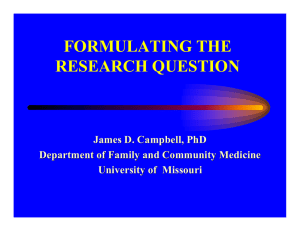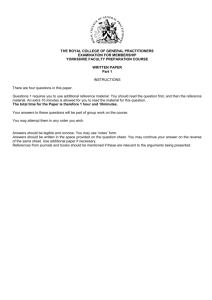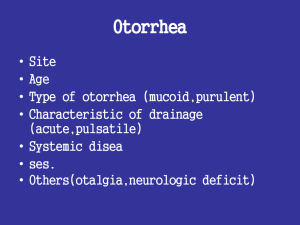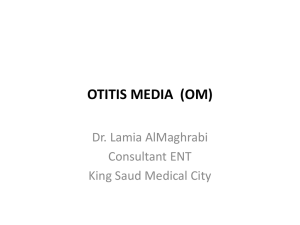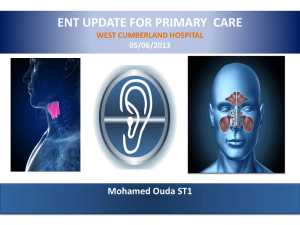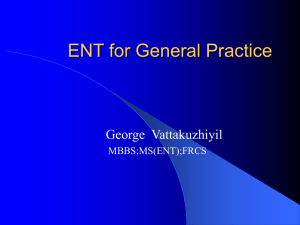- 283 - 15. OTITIS MEDIA
advertisement
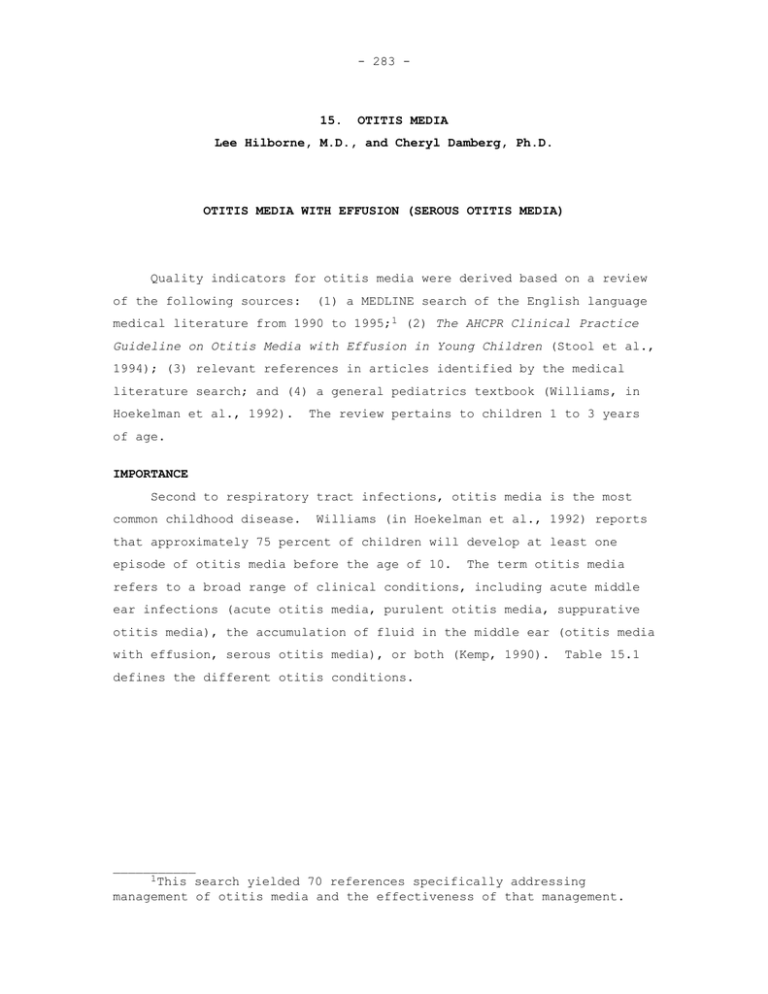
- 283 -
15.
OTITIS MEDIA
Lee Hilborne, M.D., and Cheryl Damberg, Ph.D.
OTITIS MEDIA WITH EFFUSION (SEROUS OTITIS MEDIA)
Quality indicators for otitis media were derived based on a review
of the following sources:
(1) a MEDLINE search of the English language
medical literature from 1990 to 1995;1 (2) The AHCPR Clinical Practice
Guideline on Otitis Media with Effusion in Young Children (Stool et al.,
1994); (3) relevant references in articles identified by the medical
literature search; and (4) a general pediatrics textbook (Williams, in
Hoekelman et al., 1992).
The review pertains to children 1 to 3 years
of age.
IMPORTANCE
Second to respiratory tract infections, otitis media is the most
common childhood disease.
Williams (in Hoekelman et al., 1992) reports
that approximately 75 percent of children will develop at least one
episode of otitis media before the age of 10.
The term otitis media
refers to a broad range of clinical conditions, including acute middle
ear infections (acute otitis media, purulent otitis media, suppurative
otitis media), the accumulation of fluid in the middle ear (otitis media
with effusion, serous otitis media), or both (Kemp, 1990).
Table 15.1
defines the different otitis conditions.
___________
1This search yielded 70 references specifically addressing
management of otitis media and the effectiveness of that management.
- 284 -
Table 15.1
Classification of Otitis Media
Clinical Terms
Otitis media without
effusion
Synonyms and Definitions
Synonym: myringitis
Presence of erythema and opacificaiton of the
tympanic membrane without the presence of an
effusion. May be seen in the early states of
acute otitis media or as otitis media
resolves.
Acute otitis media
Synonyms: Acute suppurative, purulent or
(AOM)
bacterial otitis media
Clinically identifiable infection of the
middle ear. Recent, rapid onset of signs and
symptoms associated with middle ear
inflammation.
Otitis media with
Synonyms: Secretory, nonsuppurative, serous
effusion (OME)
or mucoid otitis media
Otitis media without signs or symptoms of
acute disease, but with the presence of a
middle ear effusion. May be subdivided into
acute, subacute, and chronic based on
duration of effusion.
Chronic otitis media
Synonym: Chronic suppurative, purulent, or
(COM)
intractable otitis media
Presence of pronounced intractable middle ear
pathology with or without suppurative
otorrhea. Suppurative refers to an active
infection while otorrhea refers to a
discharge through a perforated tympanic
membrane.
Source: Sagraves et al., 1992.
This review focuses on otitis media with effusion, a process that
frequently follows acute otitis media.
Stool et al. (1994) estimate
otitis media with effusion represents 25 to 35 percent of all otitis
media cases.
In 1990, there were 24.5 million physician visits with the
diagnosis of otitis media.
Of the total number of visits, children
under age 15 accounted for 19.7 million visits (Schappert, 1992).
For
children younger than age 15, otitis media represented the most frequent
diagnosis for physician visits (Schappert, 1992).
According to Williams
(in Hoekelman et al., 1992), young children are more prone to otitis
media, especially those between 6 and 24 months of age.
Although
specific incidence rates vary, the Greater Boston Study found that more
- 285 -
than 60 percent of children had at least one episode of acute otitis
media by age one; 80 percent had one episode by three years of age, and
more than 40 percent had at least three episodes (Teele et al., 1989).
The prevalence of otitis media by age group is shown in Table 15.2.
Table 15.2
Prevalence of Otitis Media by Age
Age
Prevalence
Neonate
0-12%
1 year
12%
2 years
7-12%
3-4 years
12-18%
5 years
4-17%
6-8 years
3-9%
9 years
0-6%
Source: Sagraves et al., 1992.
With respect to pediatric visits, otitis media was second only to
well-child care as a reason for a physician visit (Schappert, 1992).
Children under age two have the highest rate of visits to physician
offices for otitis media (Stool et al., 1994; Schappert, 1992).
Visits
for otitis media are roughly the same for males and females.
Approximately 25 percent of all prescriptions for children under age 10
are for oral antibiotics to treat otitis media (Bluestone, 1986).
Berman (1995) notes that inappropriate antibiotic treatment of otitis
media facilitates multidrug-resistant strains of bacterial pathogens.
The estimated annual costs of medical and surgical treatment of otitis
media range between $3 and $4 billion (Stool et al., 1994; Schappert,
1992).
Hearing loss is the most prevalent functional impairment resulting
from otitis media.
If hearing loss persists, evidence, although not
entirely conclusive, suggests that patients may have impaired speech,
hearing, and language development (Lous et al., 1988; Callahan and
Lazoritz, 1988).
These problems are most common when otitis media
affects younger children.
- 286 -
EFFICACY AND/OR EFFECTIVENESS OF INTERVENTIONS
Screening
Although an ear examination is part of the recommended general
pediatric history and physical examination, controversy remains
regarding explicit screening for otitis media.
Gates et al. (1989)
recommend a screening battery when children enter school to guard
against learning problems secondary to hearing loss.
An abnormal screen
exists when the middle ear pressure is more negative than -200 mm H2O
and there is low compliance on tympanometry.
Screen failure also exists
when audiometric testing reveals inability to detect a 25 dB tone at
4,000 Hz.
However, when otitis media with effusion is suspected,
certain diagnostic tests are warranted.
Furthermore, because otitis
media with effusion frequently follows an episode of acute otitis media,
diagnostic tests are recommended for these patients.
Diagnosis
Otitis media with effusion may be asymptomatic or patients may
experience ear discomfort, hearing loss, tinnitus, possibly vertigo, or
a feeling of ear fullness.
Diagnostic tests include otoscopy (viewing
the tympanic membrane with illumination) and pneumatic otoscopy
(otoscopy viewing the tympanic membrane with small amounts of positive
and negative air pressure).
The AHCPR Guideline panel strongly
recommended the use of pneumatic otoscopy as the diagnostic evaluation
tool for suspected otitis media with effusion, because pneumatic
otoscopy can suggest the presence of effusion, even when visual
inspection of the eardrum (i.e., otoscopy alone) gives no indication of
middle ear pathology (Stool et al., 1994).
Based on limited scientific
evidence and expert opinion, tympanometry may be useful to confirm the
diagnosis of otitis media with effusion, with the inference that this
technique is more reliable than audiometry alone (Gates et al., 1989;
Kemp, 1990).
Hearing loss evaluation may be beneficial early in the disease
process (i.e., in the first 3 months of disease) and, based on expert
opinion and limited scientific evidence, is recommended for a child who
has bilateral otitis media with effusion for a total of three months
- 287 -
(Stool et al., 1994).
Tympanometry is neither an appropriate nor
reliable predictor of hearing impairment (Stool et al., 1994), given
that its positive predictive value for hearing loss can be as low as 49
percent.
Treatment
The antibiotic treatment of otitis media with effusion remains
controversial because most cases of otitis media resolve without any
intervention within 3 months (Zielhuis et al., 1990; Stool et al.,
1994).
Furthermore, there is a lack of consensus in the literature with
respect to the efficacy of antibiotics for otitis media with effusion.
(Mandel et al., 1987; Cantekin et al., 1991).
Most studies conclude
that antibiotics have a small but significantly positive effect on the
resolution of otitis media with effusion.
Williams et al. (1993) completed a meta-analysis of the literature
and demonstrated that antibiotics provided benefit in the short-term
treatment of otitis media with effusion (relative difference = 0.16; 95
percent confidence interval = 0.03 to 0.29).
However, long-term benefit
was not found when comparing the use of antibiotics to placebo (relative
difference = 0.06; confidence interval = -0.03 to 0.14).
Rosenfeld and
Post (1992), also by meta-analysis, found that antibiotics favor more
rapid resolution of serous otitis media and recommend their use in
otitis media with effusion patients.
AHCPR’s meta-analysis showed a 14
percent increase in the probability that otitis would resolve when
antibiotic therapy was given versus no treatment (Stool et al., 1994).
During the initial management period (up to 12 weeks), observation
of the otherwise healthy child with a unilateral effusion is the
treatment of choice (Berman et al., 1994).
Myringotomy, with or without
insertion of tympanostomy tubes, is not recommended for initial
management of otitis media with effusion in an otherwise healthy child
(Stool et al., 1994).
Early antibiotic therapy is also an option and
should be more strongly considered in the following situations:
•
bilateral serous otitis media, particularly when accompanied by
a hearing loss;
•
very young infants unable to verbalize complaints;
- 288 -
•
in association with a purulent upper respiratory infection;
•
when the tympanic membrane or middle ear appear possibly
damaged;
•
when episodes frequently recur (i.e., three or more times); or
•
in the presence of associated vertigo.
The choice of antibiotics is the same as those recommended for
acute otitis media given that similar organisms are isolated from both
disease processes.
Recommended antibiotics include, among others:
1) Amoxicillin (Pukander et al., 1993; Mandel et al., 1991)
2) Amoxicillin-clavulanate (McCarty et al., 1993);
3) Cefaclor (Mandel et al., 1991);
4) Cefuroxime axetil (McLinn et al., 1994);
5) Cefixime (Asmar et al., 1994);
6) Erythromycin-sulfisoxazole (Mandel et al., 1991);
7) Trimethoprim-sulfamethoxazole (Daly et al., 1991); and
8) Clarithromycin (Pukander et al., 1993; Mandel et al., 1991).
Evidence from cohort studies suggests that second hand smoke (i.e.,
passive smoke) may increase the likelihood of otitis media with
effusion, although, at present, the data are not conclusive (Maw and
Bawden, 1994; Maw et al., 1992).
Nevertheless, given the overall health
benefits to smoking cessation for both parents and children, parents who
smoke should be advised to stop and referred to a smoking cessation
program.
When considering treatment options for patients with uncomplicated
otitis media with effusion, antihistamines, decongestants, and steroid
therapy are contraindicated because they have not been shown to offer
benefit, particularly given their associated risks such as central
nervous system depression and steroid dependence (Estelle and Simons,
1994).
The AHCPR clinical guideline also recommends against
adenoidectomy and/or tonsillectomy for the treatment of otitis media
with effusion (Stool et al., 1994).
- 289 -
Patients identified as having otitis media with effusion, whether
treated or not, should be evaluated every 4-6 weeks to determine whether
there is persistence or resolution of the process (Stool et al., 1994).
Patients who have persistent bilateral otitis media with effusion
(≥ 3 months in duration) should be evaluated for hearing loss.
If
hearing loss is not severe (less than 20 db in the best ear) and the
disease is unilateral, continued observation or
continuation/introduction of antibiotics is appropriate (Mandel et al.,
1991).
In the presence of a bilateral hearing deficit (defined as 20
decibels hearing threshold level or worse in the better-hearing ear),
antibiotics or myringotomy with tympanostomy tube placement is
recommended (Bluestone et al., 1986).
However, 10 percent of children
with otitis media with effusion will have persistent disease at three
months and many of these cases will resolve without intervention (Stool
et al., 1994).
Some argue that tympanostomy tube placement is never
appropriate treatment for otitis media with effusion in the absence of a
significant hearing loss (Kleinman et al., 1994).
In any case,
placement of tympanostomy tubes as a first line of treatment is
considered inappropriate (Kleinman et al., 1994).
At subsequent follow-up (about 4-6 months), if antibiotics have
failed to resolve the effusion in patients with significant bilateral
hearing loss (as defined above), placement of tympanostomy tubes is
recommended (Stool et al., 1994).
Patients with persistent otitis media
with effusion should be evaluated for possible hearing loss (Stool et
al., 1994).
RECOMMENDED QUALITY INDICATORS FOR OTITIS MEDIA WITH EFFUSION
These indicators apply to children ages 1-3 years.
Diagnosis
Indicator
1.
All patients with the diagnosis of suspected
otitis media with effusion should be evaluated
with pneumatic otoscopy.
2.
Patients with persistent (≥3 months duration)
bilateral otitis media with effusion should have
a hearing evaluation.
Quality of
evidence
III
Literature
Benefits
Comments
Stool et al.,
1994
Prevent allergic reactions from
antibiotics. Avoid unnecessary
placement of tubes. Prevent
antibicrobial drug resisitance.
II/III
Lous, 1988;
Stool et al.,
1994; Daly,
1982; Callahan
& Lazoritz,
1988
Prevent delayed language
development and hearing loss.
Achieves better precision in making
diagnosis. Reduces false positives and
false negatives. Otoscopy alone is not
recommended since visual inspection of
the eardrum may give no indication of
middle ear pathology. Inappropriate
antibiotic treatment can lead to drug
resistance.
Recommendation based on limited
scientific evidence and expert opinion.
Quality of
evidence
I, II/III
Literature
Benefits
Comments
Stool et al.,
1994; Mandel,
1987;
Cantenkin,
1991; Williams,
1992;
Behrman,
1992
Prevent hearing and language
development problems.
Minimize discomfort and
behavior changes.
II
Stool et al.,
1994
Prevent complications of
surgery.* Prevent complications
of anesthesia.** Prevent
tympanosclerosis and persistent
perforation.
Most effusions spontaneously resolve by
3 months. Antibiotics are considered for
treatment because studies show that in 27
to 50 percent of cases, aspirates contain
bacteria or provide a medium for bacteria
to grow. Meta-analysis showed a 14percent increase in the probability that
otitis would resolve when antibiotic
therapy was given versus no treatment.
Use of antibiotics must be weighed
against the side effects and costs of
treatment.
Myringotomy at this stage has not been
shown to be of benefit and may cause
morbidity, such as external auditory canal
wall laceration, persistent otorrhea,
granuloma formation of the myringotomy
site, cholesteatoma, and permanent
membrane perforation.
Treatment
Indicator
3.
All patients with the diagnosis of otitis media
with effusion should receive either:
– antibiotics, or
– trial of observation.
4.
For all paitents with a diagnosis of otitis media
with effusion, during the initial management
period (up to 12 weeks), myringotomy with or
without insertion of tympanostomy tubes
should not be performed in an otherwise
healthy child (no other complications).
290
5.
6.
7.
All patients with the diagnosis of otitis media
with effusion who have tympanostomy tubes
should have a bilateral hearing loss (defined as
20 decibels hearing threshold level or worse in
both ears) documented in the record.
Patients with persistent otitis media with
effusion (>= 3 months duration) and hearing
loss (bilateral hearing deficits of 20 decibels
hearing threshold or worse) should receive:
a. oral antibiotic therapy if child has not been
on antibiotics, or
b. a change in antibiotics, or
c. bilateral myringotomy with tube placement;
and
d. environmental risk factor control
counseling.
Management of patients with otitis media with
effusion for 4-6 months and a history of
significant bilateral hearing loss (at least 20
decibels) and a failure of adequate antibiotic
therapy should include:
a. bilateral myringotomy with tube placement,
and
b. environmental risk factor counseling.
III
Stool et al.,
1994
Restoration of hearing. Prevent
language delay.
III
Stool et al.,
1994
Prevent hearing loss and
problems with language
development.
Because of risks associated with insertion
of tympanostomy tubes and the lack of
controlled studies documenting benefits,
this procedure should be limited to
children with more severe symptoms.
Scientific evidence is limited to support
recommendation of tube replacement;
however, strong panel consensus exists.
Exposure to cigarette smoke has been
shown to increase risk of otitis media with
effusion. The panel also noted that
parents may wish to remove children from
a child care facility.
III
Stool et al.,
1994
Prevent hearing loss and
problems with language
development.
Severity and duration of disease suggest
intervention is warrranted. Assumes
failure of antibiotic therapy.
Quality of
evidence
II/III
Literature
Benefits
Comments
Lous, 1988;
Stool et al.,
1994; Daly,
1982
Prevent hearing loss and
problems with language
development.
The AHCPR Guideline recommends a sixweek follow-up period. Eight weeks
allows plans addition time to have
accomplished follow-up.
Follow-up
Indicator
8.
All patients identified as having otitis media
with effusion must either have a
recommendation for follow-up visit or have
been seen for reevaluation within 8 weeks of
diagnosis.
*Complications of surgery include: external auditory canal wall laceration, persistent otorrhea, granuloma formation at the myringotomy site, cholesteatoma, and permanent
tympanic membrane perforation. Structural changes in the tympanic membrane are also possible, especially with repeated tube insertions. The risk of repeated tube
insertions has been estimated to be as high as 30 percent within 5 years of initial surgery.
**Complications of anesthesia include mortality, cardiac arrest, and allergic reactions.
Quality of Evidence Codes:
I:
II-1:
II-2:
II-3:
III:
RCT
Nonrandomized controlled trials
Cohort or case analysis
Multiple time series
Opinions or descriptive studies
291
- 292 -
ACUTE OTITIS MEDIA
IMPORTANCE
This review focuses on acute otitis media (AOM), a process that
frequently precedes otitis media with effusion (Fliss, et al., 1994).
Recurrent acute otitis media is defined as repeated episodes of acute
otitis, conventionally defined as three episodes of acute otitis media
(Teele et al., 1989).
The propensity for recurrent acute otitis media
is associated with onset of disease before one year of age (Fliss et
al., 1994).
Persistent acute otitis media is defined as symptoms beyond
six days of initiating therapy or recurrence within a few days of
completing at least a 10 day course of antibiotics (Fliss et al., 1994).
These children should be watched closely.
EFFICACY AND/OR EFFECTIVENESS OF INTERVENTIONS
Screening
Because acute otitis media is an acute episodic illness, screening
for this process is not appropriate.
Diagnosis
Patients with acute otitis media usually experience some or all of
the following symptoms often following an acute upper respiratory
illness:
ear pain (otalgia), fever (23 percent of patients) (Schwartz
et al., 1981), and hearing loss.
A suggestion of these symptoms by
history or nondescript findings (Baker, 1991) provided by the parents or
patient, such as irritability, lethargy, decreased appetite, vomiting,
or diarrhea should result in an otoscopic examination to observe for
redness and opacity, possibly with bulging of the tympanic membrane.
In
acute disease, the membrane will usually be less compliant and therefore
less mobile on pneumatic otoscopy.
The presence of a mucopurulent
drainage (otorrhea) may occur should the tympanic membrane be ruptured
or compromised by tympanostomy tubes.
- 293 -
Treatment
Initial treatment of acute otitis media is with antibiotics,
although studies do suggest that there is a spontaneous cure rate, in
some studies up to 80 percent (Haddad, 1994; Pichichero, 1994).
The
choice of antibiotics is the same as those recommended for otitis media
with effusion because similar organisms are isolated from both disease
processes.
Recommended antibiotics include, among others:
1) Amoxicillin (Pukander et al., 1993; Mandel et al., 1991;
Berman, 1995);
2) Amoxicillin-clavulanate potassium (McCarty et al., 1993);
3) Cefaclor (Mandel et al., 1991);
4) Cefuroxime axetil (McLinn et al., 1994);
5) Cefixime (Asmar et al., 1994);
6) Erythromycin-sulfisoxazole (Mandel et al., 1991);
7) Trimethoprim-sulfamethoxazole (Daly et al., 1991; Berman,
1995);
8) Clarithromycin (Pukander et al., 1993; Mandel et al., 1991);
9) Erythromycin (Berman, 1995) and;
10) Sulfisoxazole.
Most general discussions of the antimicrobial treatment of acute
otitis media favor the use of amoxicillin in the child without allergy
to penicillin drugs (Pichichero, 1994).
For patients who do not respond within the first two days of
treatment (i.e., 48 hours), aspiration, both for diagnosis and therapy,
should be considered; at the very least, the patient’s antibiotic
coverage should be expanded to achieve broader coverage.
The
pediatrician should inform the parents to watch the child closely for
either lack of resolution or progressive clinical signs (e.g.,
increasing lethargy) that may suggest extension of the disease.
However, Berman (1995) notes that the effectiveness of antibiotics for
acute otitis media is controversial, since in two-thirds of treated
children the clinical signs and symptoms resolve without eradication of
the middle-ear pathogen.
- 294 -
Follow-up Care
Once resolved, the child should be seen again to ensure that serous
otitis media is not present.
This evaluation should occur after the
course of antibiotics is completed.
RECOMMENDED QUALITY INDICATORS FOR ACUTE OTITIS MEDIA
These indicators apply to children ages 1-3 years.
Diagnosis
Indicator
1.
All children presenting to the clinician with
fever, nonspecific behavioral changes (e.g.,
irritability, lethargy, decreased appetite,
vomiting, diarrhea), or ear pain should receive
an ear examination using a pneumatic
otoscope.
Quality of
evidence
III
Literature
Benefits
Comments
Fliss et al.,
1994; Howie et
al., 1993
Prevent hearing loss and
problems with language
development from untreated
infections.
In young children, fever and/or nonspecific
complaints may be the only symptoms of
ear infection. Pneumatic otoscopy is more
informative than otoscopy alone as a
diagnostic tool.
Quality of
evidence
III
Literature
Benefits
Comments
Pichichero,
1994
Prevent hearing loss and
problems with language
development.
Treatment failure may be greater of the
course of antibiotic therapy is less than 10
days.
Quality of
evidence
III
Literature
Benefits
Comments
Berman, 1995
Prevent hearing loss and
problems with language
development.
Follow-up visit is necessary to determine
whether inflammation of the tympanic
membrane has resolved; persistent
infection may not be symptomatic.
Treatment
Indicator
2.
For all patients with the diagnosis of acute otitis
media, at least 10 days of antibiotics should be
prescribed.
Follow-up
Indicator
3.
Once a diagnosis of acute otitis media is
made, follow-up chart review should document
a return visit after the course of antibiotics
within 8 weeks of diagnosis.
Quality of Evidence Codes:
I:
II-1:
II-2:
II-3:
III:
RCT
Nonrandomized controlled trials
Cohort or case analysis
Multiple time series
Opinions or descriptive studies
295
- 296 -
REFERENCES - OTITIS MEDIA
Asmar BI, AS Dajani, MA Del Beccaro, et al. December 1994. Comparison of
cefpodoxime proxetil and cefixime in the treatment of acute otitis
media in infants and children. Pediatrics 94 (6): 847-52.
Baker RC. November 1991. Pitfalls in diagnosing acute otitis media.
Pediatric Annals 20 (11): 591-8.
Berman S. 8 June 1995. Otitis media in children. New England Journal of
Medicine 332 (23): 1560-5.
Berman S, R Roark, and D Luckey. 1994. Theoretical cost effectiveness of
management options for children with persisting middle ear
effusions. Pediatrics 93 (3): 353-63.
Bluestone CD. 1986. Otitis media and sinusitis in children. Drugs 31
supp (3): 132-41.
Bluestone CD, TJ Fria, SK Arjona, et al. January 1986. Controversies in
screening for middle ear disease and hearing loss in children.
Pediatrics 77 (1): 57-70.
Callahan CW, and S Lazoritz. May 1988. Otitis media and language
development. American Family Physician 37 (5): 186-90.
Cantekin EI, TW McGuire, and TL Griffith. 18 December 1991.
Antimicrobial therapy for otitis media with effusion ('secretory'
otitis media). Journal of the American Medical Association 266
(23): 3309-17.
Daly KA. August 1991. Epidemiology of otitis media. Otolaryngologic
Clinics of North America 24 (4): 775-86.
Estelle F, and R Simons. 1994. H1-receptor antagonists: Comparative
tolerability and safety. Drug Experience 10 (5): 350-80.
Fliss DM, A Leiberman, and R Dagan. 1994. Medical sequelae and
complications of acute otitis media. Pediatric Infectious Disease
Journal 13 (1): S34-40.
Gates GA, JL Northern, HP Ferrer, et al. April 1989. Diagnosis and
screening. In: Recent Advances in Otitis Media: Report of the
Fourth Research Conference (Suppl 139). Annals of Otology,
Rhinology and Laryngology 98 (Number 4, Part 2): 39-41.
Haddad Jr. J. June 1994. Treatment of acute otitis media and its
complications. Pediatric Otology 27 (3): 431-41.
Kemp ED. June 1990. Otitis media. Primary Care 17 (2): 267-87.
- 297 -
Kleinman LC, J Kosecoff, RW Dubois, et al. 27 April 1994. The medical
appropriateness of tympanostomy tubes proposed for children younger
than 16 years in the United States. Journal of the American Medical
Association 271 (16): 1250-5.
Lous J, M Fiellau-Nikolajsen, and AL Jeppesen. 1988. Secretory otitis
media and language development: A six-year follow-up study with
case-control. International Journal of Pediatric
Otorhinolaryngology 15: 185-203.
Mandel EM, D Kardatzke, CD Bluestone, et al. 1993. A comparative
evaluation of cefaclor and amoxicillin in the treatment of acute
otitis media. Pediatric Infectious Disease Journal 12 (9): 726-32.
Mandel EM, HE Rockette, JL Paradise, et al. 1991. Comparative efficacy
of erythromycin-sulfisoxazole, cefaclor, amoxicillin or placebo for
otitis media with effusion in children. Pediatric Infectious
Disease Journal 10 (12): 899-906.
Mandel EM, HE Rockette, CD Bluestone, et al. 19 February 1987. Efficacy
of amoxicillin with and without decongestant-antihistamine for
otitis media with effusion in children. New England Journal of
Medicine 316 (8): 432-7.
Maw AR, and R Bawden. 1994. Factors affecting resolution of otitis media
with effusion in children. Clinical Otolaryngology 19: 125-30.
Maw AR, AJ Parker, GN Lance, et al. 1992. The effect of parental smoking
on outcome after treatment for glue ear in children. Clinical
Otolaryngology 17: 411-4.
McCarty JM, A Phillips, and R Wiisanen. 1993. Comparative safety and
efficacy of clarithromycin and amoxicillin/clavulanate in the
treatment of acute otitis media in children. Pediatric Infectious
Disease Journal 12 (12): S122-S127.
McLinn SE, M Moskal, J Goldfarb, et al. February 1994. Comparison of
cefuroxime axetil and amoxicillin-clavulanate suspensions in
treatment of acute otitis media with effusion in children.
Antimicrobial Agents and Chemotherapy 38 (2): 315-8.
Pichichero ME. 1994. Assessing the treatment alternatives for acute
otitis media. Pediatric Infectious Disease Journal 13 (1): S27-34.
Pukander JS, JP Jero, EA Kaprio, et al. 1993. Clarithromycin vs
amoxicillin suspensions in the treatment of pediatric patients with
acute otitis media. Pediatric Infectious Disease Journal 12 (12):
S118-21.
Rosenfeld RM, and JC Post. April 1992. Meta-analysis of antibiotics for
the treatment of otitis media with effusion. Otolaryngology-Head
and Neck Surgery 106 (4): 378-86.
- 298 -
Sagraves R, W Maish, and A Kameshka. December 1992. Update on otitis
media: Part 1. Epidemiology and pathophysiology. American Pharmacy
NS32 (12): 27-31.
Schappert, SM. 8 September 1992. Office Visits for Otitis Media: United
States, 1975-90. U.S. Department of Health and Human Services,
Hyattsville, MD.
Schwartz RH, WJ Rodriguez, I Brook, et al. 22 May 1981. The febrile
response in acute otitis media. Journal of the American Medical
Association 245 (20): 2057-8.
Stool, SE, AO Berg, S Berman, et al. July 1994. Otitis Media with
Effusion in Young Children: Clinical Practice Guideline. Agency for
Health Care Policy and Research, Public Health Service, U.S.
Department of Health and Human Services, No. 12. Rockville, MD.
Teele DW, JO Klein, B Rosner, et al. July 1989. Epidemiology of otitis
media during the first seven years of life in children in greater
Boston: A prospective, cohort study. The Journal of Infectious
Diseases 160 (1): 83-94.
van Buchem FL, JHM Dunk, and MA van't Hof. 24 October 1981. Therapy of
acute otitis media: Myringotomy, antibiotics, or neither? A
double-blind study in children. Lancet 2 (8252): 883-7.
Williams RL. Otitis media and otitis externa. 1992. In Primary
Pediatric Care, Second ed. Editor Hoekelman RA, 1417-20. St. Louis,
MO: Mosby-Year Book, Inc.
Williams RL, TC Chalmers, KC Stange, et al. 15 September 1993. Use of
antibiotics in preventing recurrent acute otitis media and in
treating otitis media with effusion. Journal of the American
Medical Association 270 (11): 1344-51.
Zielhuis GA, GH Rach, and P van den Broek. 1990. The natural course of
otitis media with effusion in preschool children. European Archives
of Oto-Rhino-Laryngology 247: 215-21.
